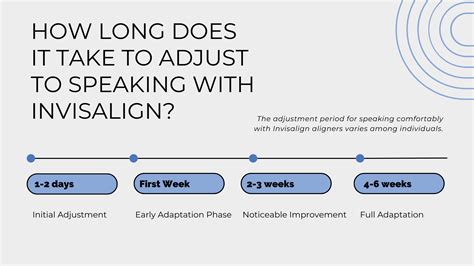Invisalign and Speech: How Long to Adjust?
Embarking on your Invisalign journey is exciting, promising a straighter smile without the noticeable metal brackets of traditional braces. However, one common concern among prospective patients is the impact on speech. Many wonder, "How long will it take to adjust to speaking with Invisalign aligners?" The answer, as with most things related to orthodontic treatment, is: it varies. This comprehensive guide will explore the typical timeframe for speech adjustment with Invisalign, addressing common questions and offering advice for a smoother transition.
How Long Does It Typically Take to Adjust to Speaking with Invisalign?
Most people find that they adjust to speaking with Invisalign aligners within 1 to 2 weeks. This period allows your mouth to get used to the presence of the aligners and the slight change they create in the positioning of your tongue and lips. However, some individuals may adapt more quickly, while others might require a slightly longer period, potentially up to a few months. Several factors influence this adjustment period, which we will explore further below.
What Factors Influence Speech Adjustment Time with Invisalign?
Several factors can influence how quickly you adjust to speaking with Invisalign:
-
Individual Variation: Just as people adapt to new experiences at different rates, the adjustment period for Invisalign varies considerably. Some individuals are naturally more adaptable than others.
-
Aligner Fit: A properly fitted aligner will cause minimal disruption to your speech. Loose aligners might move more easily, affecting your articulation, while overly tight aligners can restrict tongue movement. Regular check-ups with your orthodontist are crucial to ensure proper fit.
-
Severity of Misalignment: Individuals with more severe misalignment may find the initial adjustment period slightly longer. This is because more significant changes in tooth position may require greater tongue and lip readjustment.
-
Age: Younger patients often adapt more quickly than older adults. This likely stems from the greater plasticity and adaptability of the younger oral-motor system.
-
Initial Speech Habits: Individuals who already have a tendency to lisp or have other speech impediments may initially find the transition more challenging.
-
Consistency in Aligner Wear: Adhering to your orthodontist's instructions regarding aligner wear is crucial for both successful treatment and speech adaptation. Consistent wear minimizes the time it takes for your mouth to adapt to the presence of the aligners.
What Are Common Speech Challenges with Invisalign?
The most common speech challenges reported by Invisalign patients include:
-
Lisping: A slight lisp is often a temporary side effect, typically caused by the aligners interfering with the tongue's contact with the teeth.
-
Slurred Speech: Similar to lisping, slurred speech may initially occur as the mouth adjusts to the presence of the aligners and the slight changes in the position of the tongue and lips.
-
Increased Saliva Production: Some patients report an initial increase in saliva production, possibly due to the stimulation of the mouth’s tissues.
How Can I Speed Up My Speech Adjustment?
While individual adaptation varies, here are some tips to facilitate a smoother and faster adjustment period:
-
Practice speaking regularly: Practice reading aloud or simply talking to yourself to help your mouth become accustomed to the presence of the aligners.
-
Speak slowly and deliberately: Initially, consciously slowing down your speech can improve clarity and reduce slurring.
-
Stay hydrated: Drinking plenty of water can help alleviate any dryness in your mouth and manage increased saliva production.
Will My Speech Always Be Affected by Invisalign?
No. The speech changes are generally temporary. As your mouth adjusts to the aligners, the lisping or slurring should diminish significantly, usually within the first few weeks. By the time you complete your treatment, any speech impediments associated with the aligners should be completely resolved. If you experience persistent speech difficulties, it's vital to consult your orthodontist.
When Should I Contact My Orthodontist About Speech Issues?
While some initial speech challenges are normal, persistent or severe speech issues warrant a call to your orthodontist. Contact them if:
Persistent Lisping or Slurring: If the difficulties persist beyond a few weeks, or if they are significantly impacting your daily communication.
Pain or Discomfort: If the aligners are causing pain or discomfort that interferes with your speech or daily activities.
Difficulty Breathing: If you experience any difficulty breathing while wearing the aligners, seek immediate attention from your orthodontist.
In conclusion, adjusting to speech with Invisalign is a temporary process for most. While some initial challenges are common, they typically resolve within a couple of weeks. Open communication with your orthodontist and consistent aligner wear are key to a smooth and successful Invisalign experience.

